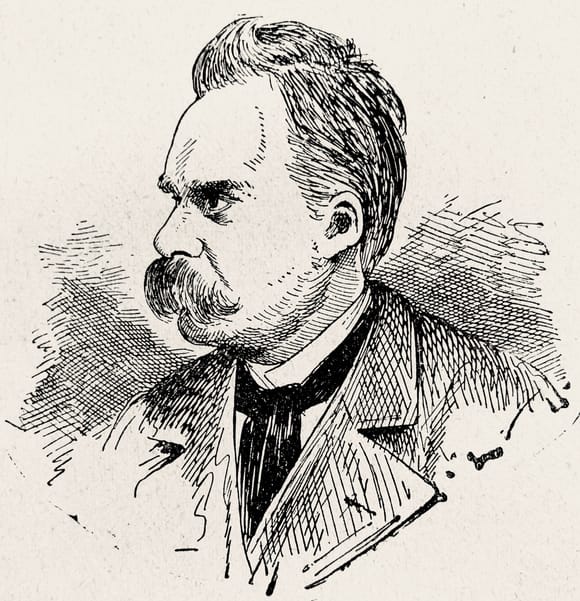Friedrich Nietzsche may be a household name, but his writings aren’t the easiest to understand.
Of his many well-known catchphrases, one of his most mysterious (and haunting) is, “Become who you are.” It appears in the very last book he wrote, Ecce Homo, less than a year before he collapsed on the streets of Turin and lost his mind forever. 1
Is “become who you are” a subtle statement, meant to be some sort of koan or brain-teaser? Or is it the self-contradicting nonsense of a man on the verge of a mental breakdown? A glimpse at Nietzche’s life gives us a clearer picture of what he meant and where he was coming from – and then you can decide for yourself if you agree with him.
Our Suffering Shapes Us
In his 20’s, Nietzsche’s star was rising. At just 24 years old he became a professor of classical philology at the University of Basel. He wrote several well-received papers and was respected by his colleagues. He was on what looked like a well-secured path to success and respectability.
Nietzsche enjoyed teaching but he wanted to expand his horizons further. He wasn’t just interested in language; he was fascinated with philosophy, with the gnarly questions about life and existence. Then he wrote his first book, The Birth of Tragedy, and his life started to pivot.
The Birth of Tragedy was a flop. It sold only a few copies and critics viciously attacked it for having a viewpoint about Greek tragedy that was, at the time, weird and controversial. One review, in particular, had a devastating effect on Nietzsche’s reputation. As a result, Nietzsche’s university lectures went from 21 students in the summer of 1872 to only 2 students that following winter semester.
If this was all Nietzsche had to deal with he might have hung onto university life, but it wasn’t.
From the time he was a child, he suffered from a combination of migraines, digestive problems, and eyesight issues; as he grew older they occurred with greater intensity (for what it’s worth, his father had died of a brain-related disease). Both in high school and later on in his career the pain was so bad at times that he couldn’t work, read, write, or even see very well.
“We are responsible to ourselves for our own existence; consequently we want to be the true helmsman of this existence and refuse to allow our existence to resemble a mindless act of chance.”
If anything, Nietzsche’s setbacks made him even more committed to the path of philosophy. In his essay Schopenhauer as Educator, he first tackled the issue of being and becoming: “[F]or your true nature lies, not concealed deep within you, but immeasurably high above you, or at least above that which you usually take yourself to be.” 2
Nietzsche believed he could be more than he was, but that it was also up to him and no one else to find meaning in his life. “We are responsible to ourselves for our own existence,” he wrote; “consequently we want to be the true helmsman of this existence and refuse to allow our existence to resemble a mindless act of chance.” 3 He knew he couldn’t get rid of his suffering, but he could at least make sense of it.
And continue to suffer he did.
His health issues became so serious that just ten years after joining the University of Basel he quit, never to return. For the rest of his life, he wandered and lived in different parts of Switzerland, France, Germany, and Italy. Sometimes he was with friends; often he was alone. Most of his relationships with others broke down, including his long-term friendship with the composer Wagner. The only woman he ever loved rejected his offer of marriage three times. Meanwhile, his health problems only grew worse.
In late 1888, Nietzsche experienced a brief lull from the physical pain he’d been suffering. He was able to write more than usual, and this included his final, crowning work, Ecce Homo. In it, he directly addresses the idea of “becoming who you are”:
“To become what one is, one must not have the faintest notion what one is. From this point of view even the blunders of one’s life have their own meaning and value – the occasional side roads and wrong roads, the delays, “modesties,” seriousness wasted on tasks that are remote from the task.” 4

“Becoming who (or what) you are,” for Nietzsche, means embracing every aspect of your life, even the mistakes and sufferings. It means amor fati – to love your fate. To accept whatever befalls you and see the meaning in it, even if it wasn’t part of your original life plan.
At first, this might sound like a contradiction: how are we supposed to be the “helmsmen” of our lives if it means accepting whatever happens to us?
Nietzsche did not advocate for a life of meekness and passivity – if anything, he railed against it. But he also understood that some things are beyond our power to change. When this is the case, we still have one thing in our control: our attitude.
Just a few months after he finished Ecce Homo, Nietzsche caused a public scene in the streets of Turin. To this day no one is sure exactly what happened, but in the end, he had a complete mental breakdown. 5 He would go on to live another eleven years but never regain his sanity.
At the time of his death in 1900, his works were still not widely read; some of them had not even been published. It would be years later before he came to influence the likes of Freud, Sartre, and countless others.
Sometimes we continue to become who we are even after we die.
We Sculpt Our Own Lives
The contemporary author and philosopher John Kaag is a big fan of Nietzsche.
As a young man, he spent several weeks hiking through the Alps, following the trails that Nietzsche had wandered over a century before. More than a decade later, he returned to Switzerland with his wife and daughter in tow. On both occasions, he had tried (and failed) to feel a deep sense of profundity about his own life by following in Nietzsche’s footsteps.
Near the end of his second trip, while watching a shepherd guide his flock across the Alpine landscape, he had this realization:
“As it turns out, to ‘become who you are’ is not about finding a ‘who’ you have always been looking for. It is not about separating ‘you’ off from everything else. And it is not about existing as you truly ‘are’ for all time.’ The self does not not lie passively in wait for us to discover it. Selfhood is made in the active ongoing process, in the German verb werden, ‘to become.’ The enduring nature of being human is to turn into something else, which should not be confused with going somewhere else.” 6
Too often we’re obsessed with the idea of “finding” or “revealing” when there is nothing to find. We are lumps of matter and it’s up to us to mold that matter; but unlike an actual physical statue or piece of pottery, the molding process for us is never finished.
The 20th-century psychologist Abraham Maslow is known for his theory of “self-actualization,” another idea that many people mistake for some sort of final solution to one’s personal growth. Maslow understood the apparent contradiction between “being” and “becoming”: “Self-actualization,” he wrote, “since I have found it only in older people, tends to be seen as an ultimate or final state of affairs, a far goal, rather than a dynamic process, active throughout life, Being, rather than Becoming.” 7
Does this contradict Nietzsche’s belief about becoming who you are? Only at first glance.
Here’s how Maslow explains it:
“[T]he process of moment-to-moment growth is itself intrinsically rewarding and delightful in an absolute sense. If they are not mountain peak-experiences, at least they are foothill-experiences, little glimpses of absolute, self-validative delight, little moments of Being. Being and Becoming are not mutually exclusive. Approaching and arriving are both in themselves rewarding.” 8
Is this not true for all of us?
Getting better at something is an enjoyable part of the process, and what “better” looks like is very much an internal thing. You can be an ultra-wealthy trust fund baby living a life of emptiness because you don’t know what you want and you aren’t reaching for anything, or you can be a Nietzsche suffering from chronic migraines and rejection but still feel alive and excited because you’re pursuing something you care about.
“It is a myth,” Nietzsche tells us:
…to believe that we will find our authentic self after we have left behind or forgotten one thing or another … To make ourselves, to shape a form from various elements – that is the task! The task of a sculptor! Of a productive human being! 9
Becoming who you are is not a mystical transformation, nor is it completing a final series of goals or life achievements. We are always becoming, and we will always have curveballs thrown at us, just as curveballs were thrown at Nietzsche throughout his relatively short and painful life.
Our proactive efforts, the things that happen to us, and how we choose to react and adapt, all combine to make us who we are.
***
Read Next: Braving the Wilderness: How to Live to Yourself →
Footnotes
- To this day, no one is sure what exactly caused Nietzsche’s mental breakdown, but the theory of syphilis has been debunked. Most likely he had a brain tumor and/or a stroke, possibly from a hereditary condition.
- Breazeale, Daniel, editor. Nietzsche: Untimely Meditations. Cambridge Texts in the History of Philosophy, Cambridge University Press, November 6, 1997.
- Ibid.
Nietzsche, Friedrich. On the Genealogy of Morals and Ecce Homo. Edited by Walter Kaufmann, Vintage, December 17, 1989.- The popular story is that Nietzsche threw his arms around a horse, but this is most likely apocryphal.
Kaag, John. Hiking with Nietzsche: On Becoming Who You Are. Farrar, Straus and Giroux, September 25, 2018.- Maslow, Abraham. Toward a Psychology of Being. Start Publishing LLC, 2012.
- Ibid.
- This is from a fragmentary note of his, not a published work.
